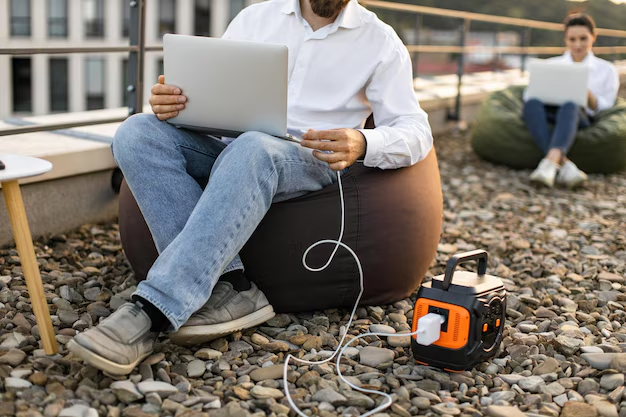How to Choose the Right Power Bank for Your Lifestyle Leave a comment
In today’s connected world, a power bank is a lifesaver for keeping your smartphone, tablet, earbuds, or laptop charged on the go. Whether you’re a frequent traveler, a busy professional, a student, or an outdoor enthusiast, choosing the right power bank can make all the difference. With so many options available, this guide will help you select the perfect power bank for your lifestyle by focusing on key factors like capacity, portability, charging speed, and more. Here’s everything you need to know to make an informed decision.
1. Determine Your Capacity Needs
The capacity of a power bank, measured in milliampere-hours (mAh), determines how much charge it can store and how many times it can recharge your devices.
- What to Consider: Think about the devices you’ll charge and their battery sizes. For example, a typical smartphone has a 3,000–5,000mAh battery, while tablets or laptops may require 10,000–20,000mAh. Consider how many full charges you need per day.
- Casual Users (e.g., daily commuters): A 5,000–10,000mAh power bank is sufficient for charging a smartphone or earbuds 1–2 times.
- Travelers or Heavy Users: Opt for 20,000mAh or higher to charge multiple devices or a single device multiple times.
- Outdoor Enthusiasts: Choose a rugged power bank with 10,000–20,000mAh for durability and multiple charges during trips.
- Pro Tip: Check your device’s battery capacity (listed in settings or specs) and multiply by the number of charges needed. Account for efficiency loss (typically 70–80%), as not all rated mAh translates to actual output.
- Example: To charge a 4,000mAh phone twice, a 10,000mAh power bank (accounting for ~75% efficiency) is ideal.
Keyword Tip: Search “best power bank capacity for smartphones” to find models suited to your device.
2. Prioritize Portability vs. Power
Power banks vary in size and weight, so your lifestyle dictates whether portability or capacity takes priority.
- What to Consider:
- Compact and Lightweight (Students, Commuters): Choose a slim 5,000–10,000mAh power bank that fits in a pocket or small bag. These are ideal for daily use and short trips.
- High-Capacity (Travelers, Professionals): A 20,000–30,000mAh power bank is bulkier but better for long trips or charging multiple devices, like laptops and tablets.
- Outdoor Use: Look for rugged, water-resistant models with mid-range capacity (10,000–20,000mAh) that balance portability and durability.
- Pro Tip: Check the power bank’s dimensions and weight in product specs. For example, a 10,000mAh power bank weighs around 180–250g, while a 20,000mAh model may weigh 350–500g.
- Why It Matters: A lightweight power bank is easier to carry daily, but a larger capacity is better for extended periods without access to outlets.
Keyword Tip: Search “portable power banks for travel” for compact, travel-friendly options.
3. Check for Fast Charging Compatibility
Fast charging can significantly reduce the time it takes to recharge your devices or the power bank itself.
- What to Consider: Ensure the power bank supports fast-charging standards compatible with your devices, such as USB-C Power Delivery (PD) or Qualcomm Quick Charge (QC).
- Smartphones and Tablets: Look for at least 18W–30W USB-C PD for fast charging. Most modern phones (e.g., iPhone, Samsung Galaxy) support these standards.
- Laptops: Choose a power bank with 45W–100W PD output for USB-C laptops like MacBooks or Dell XPS models.
- Recharging the Power Bank: A power bank with fast input (e.g., 20W or higher) recharges itself quicker, saving time.
- Pro Tip: Verify that your device and cable support the same fast-charging protocol as the power bank. Use high-quality, certified cables (e.g., USB-IF or MFi-certified) for optimal performance.
- Why It Matters: Fast charging can provide hours of use from just a 10–15-minute charge, ideal for busy lifestyles.
Keyword Tip: Search “best fast-charging power banks 2025” to find high-speed models.
4. Evaluate Port Options and Multi-Device Charging
The number and type of ports on a power bank determine how many devices you can charge simultaneously and what types of devices are compatible.
- What to Consider:
- Single-Device Users: A power bank with one USB-A or USB-C port is sufficient for charging a phone or earbuds.
- Multi-Device Users (e.g., Professionals, Families): Choose a power bank with multiple ports (e.g., 1 USB-C and 2 USB-A) to charge a phone, tablet, and earbuds at once.
- Laptop Users: Ensure the power bank has a USB-C PD port with sufficient wattage (45W or higher) for laptop compatibility.
- Pass-Through Charging: Some power banks allow simultaneous charging of the power bank and connected devices, ideal for overnight charging.
- Pro Tip: Look for power banks with smart power allocation, which automatically adjusts output to prioritize faster charging for each device.
- Why It Matters: Multiple ports and versatile outputs ensure you can charge all your devices without carrying extra adapters.
Keyword Tip: Search “power banks with multiple ports” for models supporting multi-device charging.
5. Consider Special Features for Your Lifestyle
Additional features can make a power bank more suited to specific needs, enhancing convenience and durability.
- What to Consider:
- Travelers: Look for power banks with airline-compliant capacity (up to 27,000mAh or 100Wh, check airline regulations) and built-in cables for convenience.
- Outdoor Enthusiasts: Choose a rugged power bank with IP65 or higher water/dust resistance and shockproofing for camping or hiking.
- Tech Enthusiasts: Opt for power banks with wireless charging (Qi-compatible) for cable-free charging of phones or earbuds.
- Safety Features: Ensure the power bank has protections like overcharge, short-circuit, and temperature control to prevent damage to your devices.
- Pro Tip: Some power banks include LED indicators, built-in flashlights, or solar charging for emergencies, which are great for outdoor or travel use.
- Why It Matters: Features tailored to your lifestyle enhance usability and ensure the power bank meets your specific needs.
Keyword Tip: Search “rugged power banks for camping” or “wireless charging power banks” for specialized models.
Bonus Tip: Check Brand Reputation and Warranty
Not all power banks are created equal. Stick to reputable brands like Anker, Belkin, Xiaomi, or Baseus, known for quality and safety. Check customer reviews and ensure the power bank comes with a warranty (typically 12–18 months) for peace of mind.
- How to Do It: Read reviews on trusted platforms and verify the power bank’s certifications (e.g., CE, FCC, RoHS) for safety compliance.
- Why It Matters: Reliable brands reduce the risk of issues like overheating or premature failure, ensuring long-term value.
Keyword Tip: Search “best power bank brands 2025” for trusted recommendations.
Conclusion: Find the Perfect Power Bank for You
Choosing the right power bank comes down to balancing capacity, portability, charging speed, and features to match your lifestyle. Whether you need a compact model for daily commutes, a high-capacity option for travel, or a rugged power bank for outdoor adventures, there’s a perfect fit for you. Use this guide to narrow down your options and keep your devices powered up wherever you go.
Call to Action: Found the perfect power bank? Share your choice in the comments below! For more tech tips, subscribe to our newsletter and stay updated on the latest gadgets.
Keywords: choose power bank, best power bank for travel, fast-charging power bank, power bank for smartphones, rugged power bank for camping, wireless power bank, multi-device power bank

